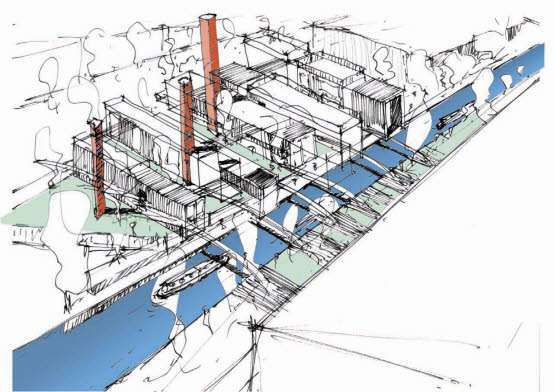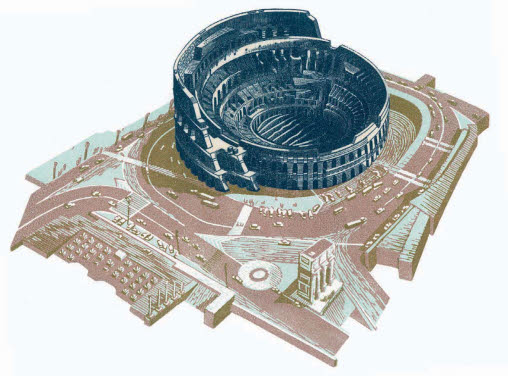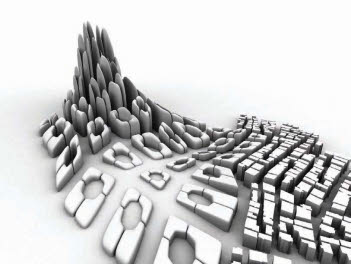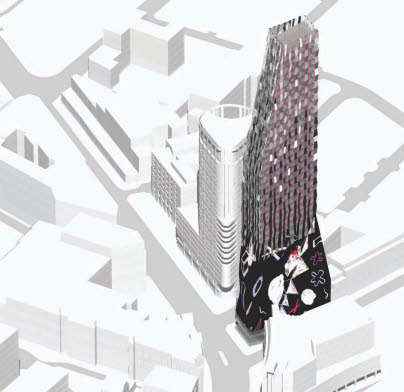Case Studies: Axonometric and isometric projections

1
1. This sketch isometric study by Kyle Henderson illustrates how useful this kind of projection can be in representing an overall idea in its context. The pen sketch shows not only the form of the buildings, but sufficient detail to distinguish primary material differentiations. The context is mapped out in less detail, but the relationship between the building form and the series of bridges is clearly emphasized, with each bridge casting a well-defined shadow on the waterway below. The sketch is scanned, and areas filled in Photoshop represent a further layer to the narrative that is about the landscape, gardens, and external spaces interspersed between buildings. The isometric sketch allows this building strategy to be represented as a whole, and because of the “opening up” of the axis in this kind of projection, offers glimpses into the spaces between buildings.

2
2. By contrast, this well-known drawing of the Villa of the Physicist by Eric Parry is a more developed study using collage, pencil, inks, and pastel. The basic form of this drawing is a simple isometric. Set against the black external masonry piers, the mysterious interior seems to draw its light from the landscape that is sketched in around it. The contrast in technique here is important, as the pastel and soft pencil easily fade into the distance and allow the building to appear as though integrated within it. In this drawing there is a wonderful balance between the constructed and the landscape, between light and dark, and between elements that are well defined and others that are more open to interpretation.

3
3. Inspired by an old postcard, A Slice of Rome by the artist Anne Desmet illustrates axonometric projection in an urban situation, in this case to show one of Rome’s best-known landmarks in context. The image is made from a lino-cut and collaged wood-engraving on white paper. The road system surrounding the Colosseum is a three-color reduction lino-cut print; the collaged Colosseum engraving superimposed on top is printed in blue/black ink onto cream Japanese Kozu-shi paper. The surrounding roads are bent, exaggerated, or truncated to make a strong overall composition, but the image has a wonderful sense of movement that is born out of the detail within the image and the textures and colors of the print.

4
4. Zaha Hadid Architects, Kartal-Pendik masterplan, Istanbul. These drawings, vertical projections from a “soft” grid in plan, illustrate the use of axonometrics to describe urban topography and building form at an urban scale. In the upper image note the simple technique of leaving the existing fabric in plan, projecting only the proposed development.


5
5. There are parallels between the visual character of the postcard-inspired image and this urban axonometric by Will Alsop. Alsop’s axonometric is unequivocal in the way it draws attention to the focus building: the detail of the context is sufficient to describe the textures and scale of the city, but in a way that does not distract from the visual allure of the tower, with its distinctively inventive façade treatment.

6
1. Solar energy heats owner’s hot water
2. Gray water collected for toilet flushing, etc
3. Counterbalance
4. Steel truss supports uppermost floor plate
5. Lower floors suspended by perimeter cables tied back to uppermost floor (max 46 x 881⁄2 ft/14 x 27 m column-free floor plates)
6. No fritting to north-facing elevation
7. Limestone-clad core
8. Single-glazed inner “skin”
9. Blinds within the cavity block low winter sun
10. Double-glazed outer “skin”
11. Frit pattern on glass prevents excessive solar gain (frit-pattern density varies by facet)
12. Column-free ground floor with double-height reception space
13. Sun path
6. Stephenson Bell’s exploded axonometric shows their proposal for a building on Fountain Street in Manchester. The drawing is an exploded isometric drawing and was produced at presentation stage to convey the holistic design approach taken with the architectural design. The drawing is a pen-on-tracing-paper sketch over a static shot of a virtual model that was produced in 3ds Max. The sketch was then scanned and additional information added in Photoshop to produce an image capable of clearly explaining all aspects of the architectural, structural, and environmental principals at once. The image was then used in conjunction with renderings taken from the virtual model to form a cohesive presentation.
